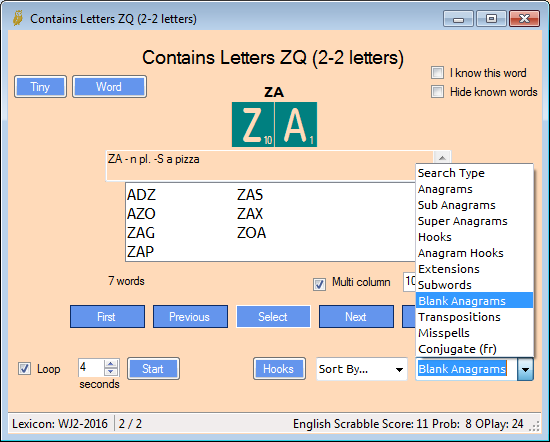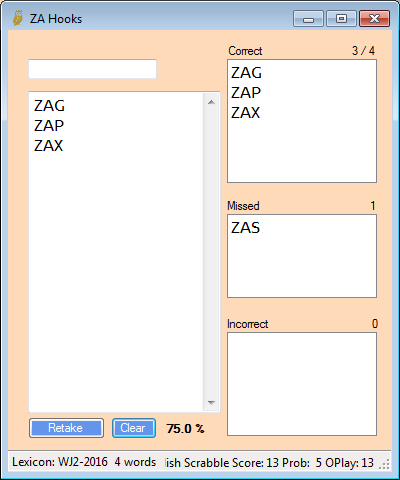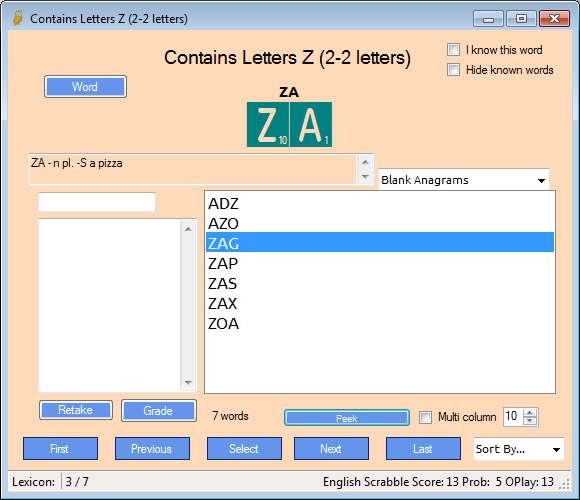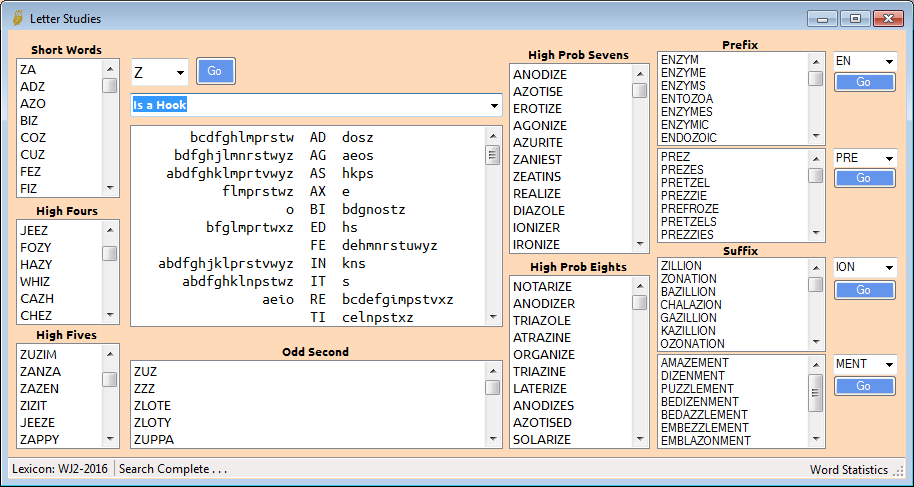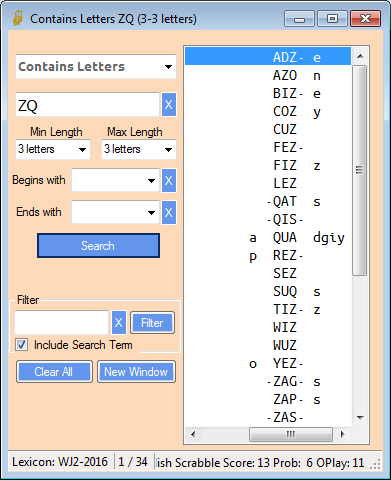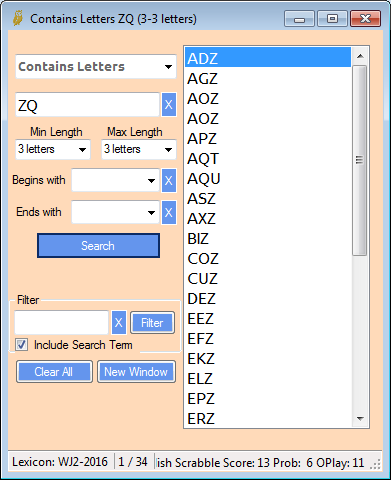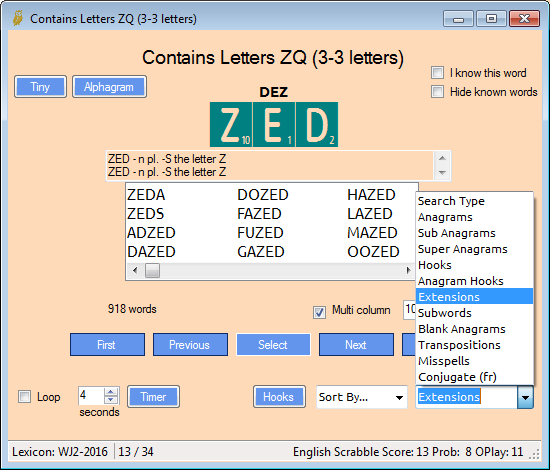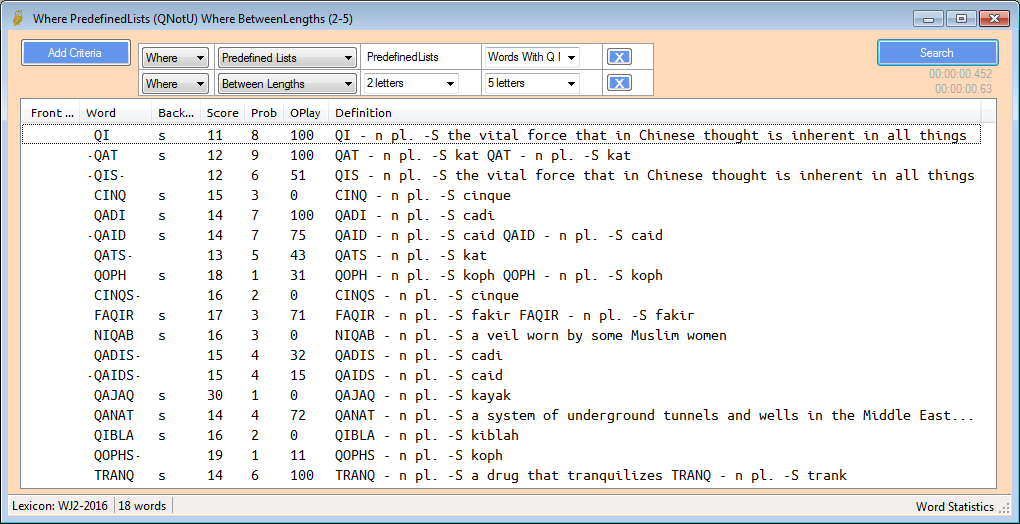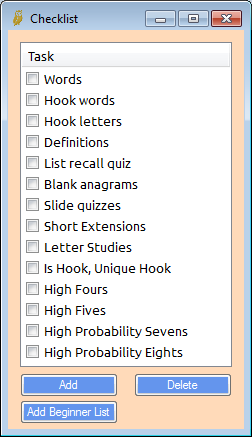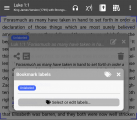| « Apps for Scrabble Word Study | Images in b2evolution » |
Watch your Z's and Q's
Since the release of Version 2 of Hoot, I have been making only minor changes to the program. Instead, I've been focusing on two other projects; the development of a new lexicon (NAWL), and organizing notes for a study guide for Hoot. I am attempting to assemble study wisdom of other Scrabble players along with my own study preferences to help players make the best use of Hoot. My last post was a preview of the section on Scrabble play.
While the documentation provided in Hoot should help you learn how to navigate the software, it doesn't provide any guidelines on how to use Hoot to study Scrabble words. This post contains a little more about Scrabble study strategy. In other words, the guide would show what to study and how to study in Hoot, and possibly other resources.
This segment deals specifically with the two 10-point tiles, Z and Q, and is more of an outline for other study tips. Included are sections for Searches, Slide Shows, Quizzes, Letter Studies, Placement Studies, some Special Studies (QnotU), and finishing with a Checklist.
The techniques here can be added to study of other letters. Traditionally, the advice is to also study words with 8-point letters J and X, so you can expand it to include these letters. You could also include C and V in the set since there are no 2 letter words with those letters.
There's different opinions on when to learn the high tile letters. My order puts three/four letter high tile and QnotU after you've learned all the two letter words. Others suggest you learn the 3-letter words first. In any case, it should be early.
Note: Click on images to see them full size. Then go Back in your browser to get back to the post.
Combination Search
To focus on Z's and Q's in Hoot you can use the Combination search. Select Combination from the ribbon and then select Search Type "Contains Letters". Enter the letters, select the lengths, and click to Search.
There are only two two-letter words, 34 three-letter words, and 113 four letter words. Most of those are Z words. Instead of studying the lists in that order, it may be better to study them with hooks as a consideration and study the shortest words in more depth.
Mental Hook Words
Now set the length to 2 letters to display just the two two-letter words, switch to Hooks Display, and mentally create the three letter words created by adding each hook letter. There's not many for the two-letter words but this study tactic should become habit as you expand your studies.
As you study, notice the hook letters, not just the words that are formed. This can help you quickly identify the relevant letters on your rack.
Definitions
At one point you may want to see the definitions. Simply change display to definitions.
Slide Shows
Slide Show Hooks
Continuing with the two-letter exercise, while the search window is selected, click on Slide Show in the Slide Show panel on the ribbon.
This will display each word separately. From the Search Type drop-down select Hooks. As you move to each new primary word (using Previous, Next) the hook words are displayed for that word. As a slide show you can also start the show by setting the number of seconds to delay and then clicking on Start.
Slide Show Blank Anagrams
While Hooks are important, you may be able to play the letters in the primary word in a different order with different letters. Blank Anagrams includes all letters in the primary word plus one other letter and arranges them to form other words. Select Blank Anagrams from the Search Type dropdown to change the display. In addition to the four hook words (ZAG, ZAP, ZAS, and ZAX), you can play ADZ, AZO, and ZOA.
You may want to study J and X in the same way before delving into the three letter words.
Quizzing
Self quizzing is an important aspect of mastering a subset of words and building confidence in your word study. Hoot has two types of quizzes. The List Recall tests the ability to recall a list of words. The Slide Show Quiz tests the ability to form words based on each primary word and the selected subsearch.
List Recall
Go back to the original search window for two letter words. Now right-click and select Quiz List Recall near the bottom of the list.
The title of the window that is displayed indicates the search that the quiz is for. The status bar also indicates the number of correct words in the list. If you expand the window to the right you can see the answers. That can be used as a review of the list before you start.
On the left side, there is a small box and a larger box. In the larger box enter the words in the list. When finished, press the Grade button to see the results.
Now, clear the list by clicking on the Retake button. This time, enter each word separately in the smaller box. Notice that you get immediate feedback after each word. If you want to clear the feedback, press Clear.
Slide Show quiz
The slide show quiz tests your mastery of the subsearches. Switching back to the search window and right-clicking you can select the Slide Quiz option from the list. You could also just select Slide Quiz from the ribbon.
For Search Type select Blank Anagrams this time. Like the recall there will be Correct, Missed, and Incorrect boxes. There is a Peek button that lets you review the list of words and the number of correct answers is shown to the left of the Peek button.
Taking the quiz is the same as the recall quiz.
Letter Studies
There are some even deeper studies you can do with Hoot as you attempt to master your Z's and Q's. One useful tool for studying on a letter-by-letter basis is Letter Studies. Letter Studies presents multiple lists based on the containing letter. Separate boxes show the short words (sorted by length), odd seconds, prefixes, suffixes, etc.
From the ribbon select Letter Studies. From the drop-down select the letter you want to study. Once you select a letter Hoot will begin the search. Don't press Go unless you are studying a letter combination like GH.
The short words are in the box in the top left and includes words up to 5 letters long, sorted by length, then alpha. One useful list here is the odd second near the bottom. This includes words with the letter followed by an odd second letter. For Z, an odd second letter is the L, as in ZLOTE.
Custom
The large box in the top center of the window is reserved for custom searches. As hinted earlier, this can be used to do things like find words where the letter IS a hook. For Z there is a long list of words that can be hooked onto. A few words exist that take only Z as a hook. Most of these unique hook words are ZZ words, but notice OOGENY and OOLOGY as well as INCITES that can be used to form ZINCITES.
You can also find words containing the letter that have no hooks. For example, CUZ, FEZ, LEZ, and others can be safely played so that an opponent can not hook onto it. But most can be extended with two or more letters.
Placement Studies
Two boxes in Letter Studies are devoted to High Plays, that is High Fours and High Fives. As a background, notice on the scrabble board that there are several places where the TW and DL and four (or five) spaces away. Playing the high tile on the DL and extending to the TW multiplies that letter by six. These lists have a beginning or ending letter worth at least 4 points.
This includes some words that are not likely, so instead of studying words like ZIZZ, JAZZ, RAZZ, so you may want to focus on more realistic ones like DOZY, FAZE, etc. While DOZY is only worth 17 points, if it is played on the top left corner with the Y covering the DL square, it is worth 63 points (plus the value of any adjacent words formed). Similarly, there are many places on the board where 5 letter words reach a TW and DL square and knowledge of High Fives would be valuable.
Pattern
Most of the result boxes in Letter Studies only shows the list of words so in order to study high fours more effectively, it may be more useful if you switch to the Combination search window and use a pattern search. For words beginning or ending with Z, select Pattern and enter (Z???|???Z). This shows 4 letter words beginning or ending with a Z. After display, sort by probability ascending (click twice) so that ZOEA, ZINE, ZETA, are at the top. It's best to study the words that you are most likely to be able to play.
In Hoot there are several other lists of high plays in Predefined Lists and Query. Note that beginning with 2.0.4 the predefined lists here include words beginning or ending with FHKVWY. Version 2.0.3 limited the results to words not containing JQXZ. There is a separate option for words beginning or ending with JQXZ. In Predefined lists you can't filter based on a selected letter, but you can in Query.
Three Letter Words
Studying the two letter words is a basic step to mastering some of the fundamentals of word study. While you can focus on words, hooks, and blank anagrams for two letter words, mastering longer words will involve more variation in study technique.
After mastering the two letter words, change the length to 3 letter words in the original search window. You may already know many of them after studying the two letter hooks words and blank anagrams, but many of them, like BIZ and COZ, are words not created by either hooks or blank anagrams. Follow the same steps in reviewing these words. Notice the hook letters for each word and mentally create the hook words that are formed by hooking. You may also notice that there is a tick mark at the beginning or end of words. That indicates that letter can be removed to form the shorter word.
Notice that ADZ has a back hook E, and that the Z has a tick mark indicating that the Z can be removed to form the shorter AD. In other words, Z IS a hook to the word AD, but more about that in letter studies.
Alphagrams
At this point it may be prudent to test yourself and learn about alphagrams. An alphagram is the word with the letters of the word sorted. Some players remember a word or set of words by remembering the alphagram, particularly if that alphagram can be used to remember multiple words or stems.
While there are quizzes for review, you may benefit by simply showing alphagrams and mentally creating the words as preparation for the quiz. With the list displayed, select Alphagrams from the Display panel on the ribbon, and then Alphagram from the Sort panel.
Notice that some of the alphagrams will be the same. For example, there are two separate words with the alphagram AOZ.
Some programs include an anagramming tool that allow you to shuffle, or re-arrange the letters of the word randomly.
Continue the exercises you did when studying two letter words by displaying the slide show and showing hooks and blank anagrams subsearches.
Extensions
As you review the three letter words in the slide show you may notice that some of these words do not have hooks. CUZ and FEZ are a couple. Even though a word has no hooks that doesn't mean you can't play on it. In many cases you may be able to extend it. You may lose the ability to hook onto the word, but extending it could reach a bonus square that will multiply your score.
While in the slide show, change the Search Type to Extensions to see words that can be extended. For example, ZED is a common extension to many words.
The display includes all extensions but you will want to focus on some of the shorter ones. You can also view extensions of individual words using the Combination search window. While viewing extensions, click on the Hooks button and you can see hooks and inner hooks just as they appeared in the original search window. For ADZE, you can add either D or S to the end, or take the E off the word to form another word.
As you go through the words you may notice that a few are also dead end words (no hooks or extensions). It's useful to remember that currently there are no hooks or extensions to SEZ and WUZ. While all of these words may seem overwhelming remember that the more of the hooks and extensions you learn the shorter the list of longer words you have to memorize.
Q not U
While all letters can be studied in much the same way, the Q is an anomoly. In most cases, Q is followed by a U. If you don't have the U, it is important to know the words that don't require a U.
Predefined Studies
Under either Beginners or Special, select Words With Q Not U. Select the length and search. To manage the study, start with 2-4 letters, and gradually increase the length until you have 2-8 letters. There are only 47 words in this list. Within the list, 23 of the words take an S right hook.
Note: You can also conduct this search in the Query and see more details for each word. In Query, select Predefined for Search Type, and Q not U. Add Criteria and select Between Lengths as Search Type.
Now go through the same hooks, blank anagrams, and extensions as before. You can do this in several ways, although the slide shows will cover everything. In this list, notice that QIS is a dead end word (there are no hooks or extensions) along with every QnotU word ending in S;
Checklist
While it would be orderly to study incrementally longer words for each letter the benefits only go so far. For example, before trying to master five letter words, or even four letter words, you would be better off studying bingo stems. But while you are studying a word list on a letter-by-letter basis you might find this checklist useful for each letter, and word size; or you can create your own checklist in Hoot.
Repeat the checklist for each letter length, and then start over with other letters. I would study the following letters next. JX, K, CV, FWHY...
When you get to the more common letters, you may want to change your study options. Instead of studying the shortest words containing A, you may want to study words with two A's.
The End (and Beginning)
While you've read a lot to get to this end, this is really just a beginning. I would like to compile a more comprehensive resource for word study with Hoot, and will be basing much of it on this outline. Let me know your thoughts, via contact form or tweets (@dbell154).





